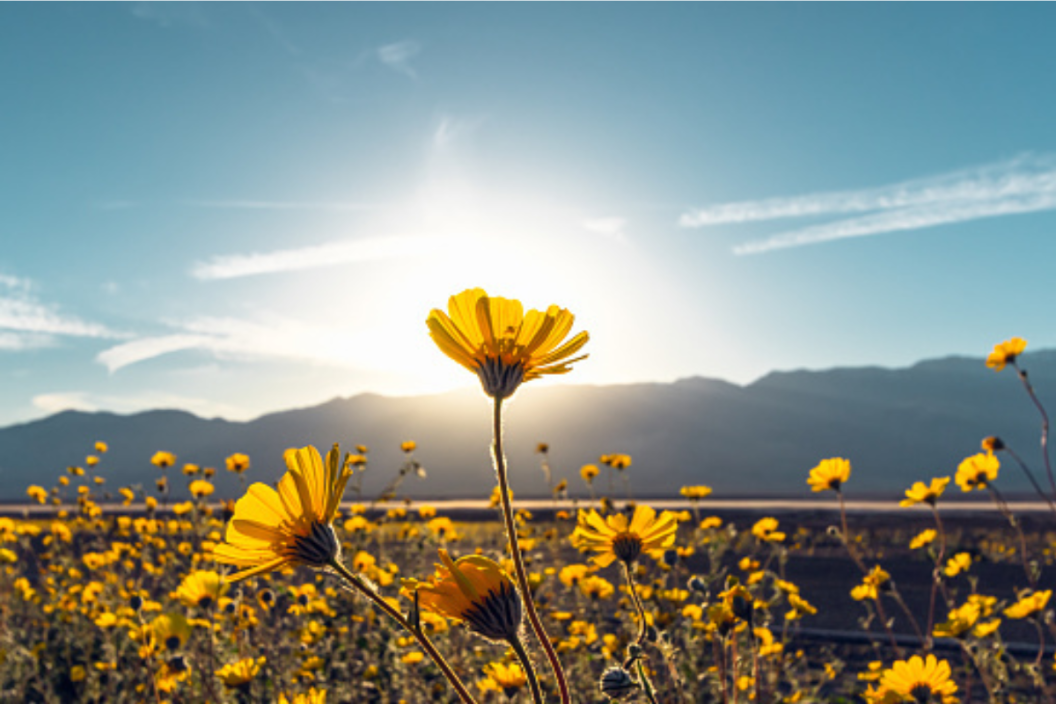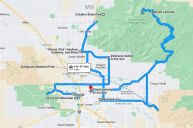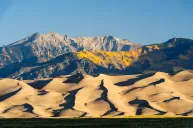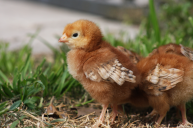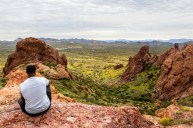Californians have endured a long 2023 winter pelted with hail, snow, and heavy rainfall. But the seemingly endless wet weather has a silver lining: a magnificent super bloom.
In fact, the eruption of flowers throughout the state is so extraordinary that the massive floral footprint can be seen from space.
NASA released images highlighting the areas with concentrations of flowers, including Carrizo Plains. Space intelligence and technology company Maxar Technologies joined in with its own super bloom admiration. The company released highly detailed satellite images highlighting brighter displays of flowers in popular destinations. The images showed brilliant hues of orange, yellow, purple, and green flooding the hillsides of Southern California.
As locals know, flowers in these valleys bloom yearly, and last year's blooms were also magnificent. You may wonder why this year's display is getting so much attention and what makes it a super bloom. We have California's unseasonably wet winter to thank for the phenomenon.
Historic atmospheric rivers throughout the winter and early spring—paired with California's trademark sunshine—set the stage for this year's main event, a springtime eruption of color emanating from every hillside.
"California's desert state parks are cautiously optimistic in expecting a 'good' to 'better than average' wildflower bloom this late winter and spring seasons depending on the continued weather conditions," the California Department of Parks and Recreation wrote on its website.
The Chico Hiking Association put it perfectly on its Facebook page when one of its followers posed the very same question. "[The] biggest factor seems to be continuously damp ground November to April. What usually hurts the bloom (is) a few weeks of warm, dry weather, usually in March. The most showy flowers are in thin soil on top of the Lovejoy Basalt; they are showy because they need to attract insects quickly before the soil dries out and the plants shrivel. If the soil were thicker, the annual grasses would tend to crowd them out. This year has had an extremely good rainfall pattern, and the thin soils have remained moist enough for most all of the growing season."
Check out our list of must-see spots to see this historic super bloom in person.
Southern California
With warmer days and cloudless skies, the majestic super bloom in California has hit Southern California first. With as much rain as the southern portion of the state soaked up this year, flowers are exploding everywhere. From San Diego up to Santa Barbara, blooms can be seen gracing the hillsides, plains, and trails. Here are a few Southern California spots to observe the spring florals.
Antelope Valley Poppy Reserve
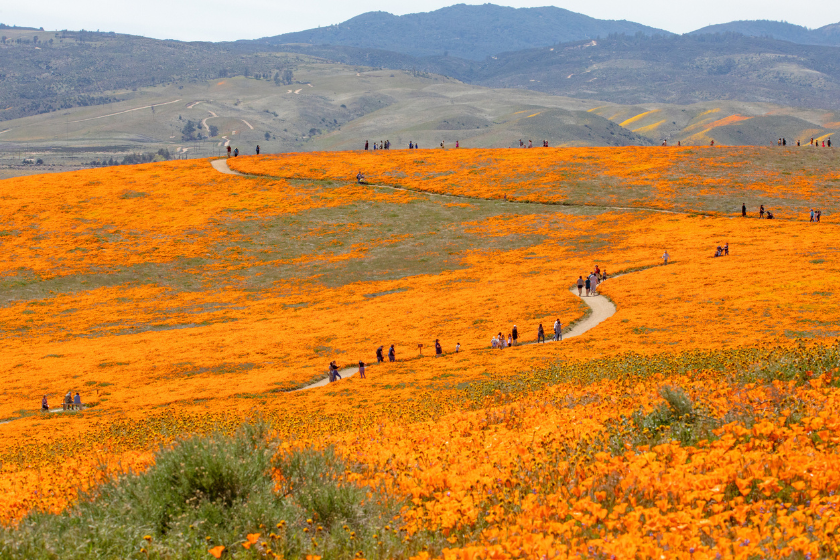
Getty Images
Wildflowers pop up in this desert oasis from mid-February through May. Visitors will experience various colors, with no two days looking the same. The trail consists of 8 miles of easy-to-hike paths, which include paved sections for wheelchair access. The often-windy trails are dog-free, and the park strongly emphasizes that visitors stay on the official trails.
The website states, "Getting a picture of one really nice wildflower off the trail will crush all the plants along the way and compact the soil, leaving lifeless bare dirt for the next few years or longer." Drones are also prohibited from flying over the reserve. Be prepared to pay for parking at the reserve. The cost will vary based on vehicle type.
Anza-Borrego Desert State Park
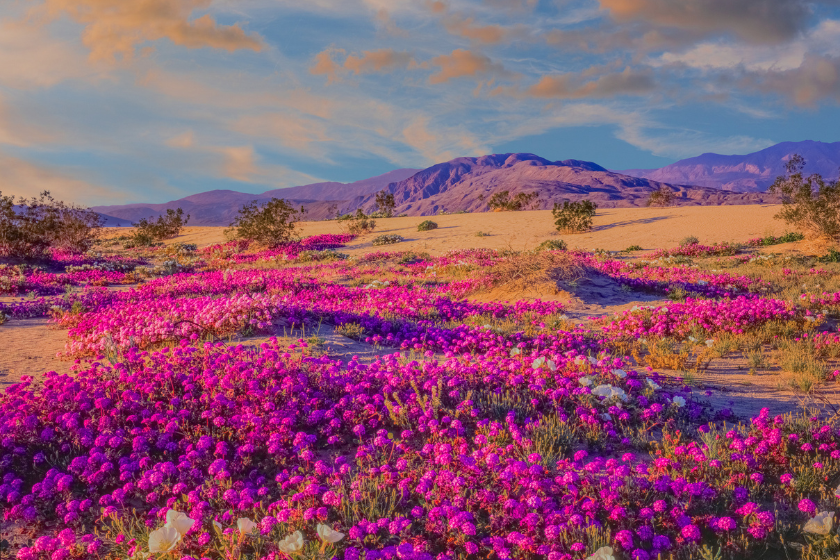
Getty Images
Anza-Borrego Desert State Park, located outside San Diego, consists of almost 600,000 acres of rugged desert. The rugged valley is the largest state park in California and spans three different counties: San Diego, Imperial, and Riverside. The unique park has 12 different wilderness areas and miles of trails. Wildflowers can be found throughout the park despite being in the middle of the desert. The visitors center has chuparosa, barrel cactus, desert dandelions, beavertail cactus, heliotrope, and brittlebush. Hellhole Canyon has many of the same flowers, while Cactus Loop Trail at Tamarisk Grove has fishhook cactus, cholla, and beavertail cactus.
Diamond Valley Lake

David McNew/ Getty Images
Located in Hemet, California, Diamond Valley Lake's wildflower trail is open to visitors from Wednesday through Sunday. Dogs are not allowed on-site, to preserve the flowers and protect the wildlife within the reserve. The 800,000-acre lake is also a drinkable water source for Southern California, so there is no swimming. However, fishing is allowed for those who want to cast a line after viewing the wildflowers.
Blooms can be seen from the 21-mile Lakeview Trail and the 6-mile North Hills Trail. The Lakeview Trail is open to pedestrians and bicyclists, while equestrians and pedestrians can use the North Hills Trail. Parking costs $11 per vehicle, and access to the trails costs $4 per person.
Chino Hills State Park
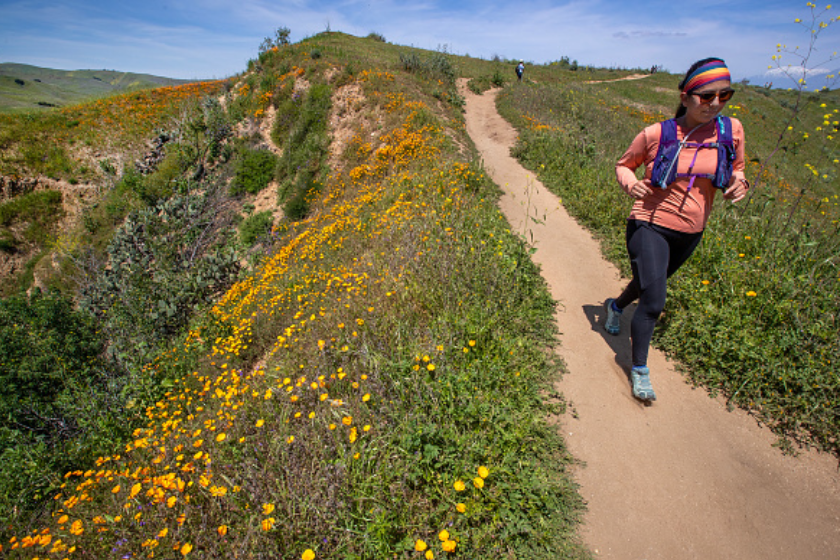
Allen J. Schaben / Los Angeles Times via Getty Images
Chino Hills State Park is home to a plethora of wildflowers. In addition, visitors may be able to see various native and invasive plant life, including the California poppy, Canterbury bells, black mustard, arroyo lupine, school bells, and wild radish. Many can be seen from the park's 90 miles of multi-use trails. The park is also home to over 200 different species of wildlife.
As with the other parks, dogs are not allowed on the trails, nor are drones permitted. The park is open daily from 8 a.m. until 7 p.m. Visitors can stay overnight in the camping area with a reservation in an RV or tent.
Central California
Central California is decked with wildflowers from the hillsides to the sea. Drivers traversing the I-5 are treated to colorful displays of poppies, lupine, and yellow daisy, to name a few. The ever-changing landscape of central California is full of opportunities to see the super bloom. Here are a few of our favorites.
Grass Mountain
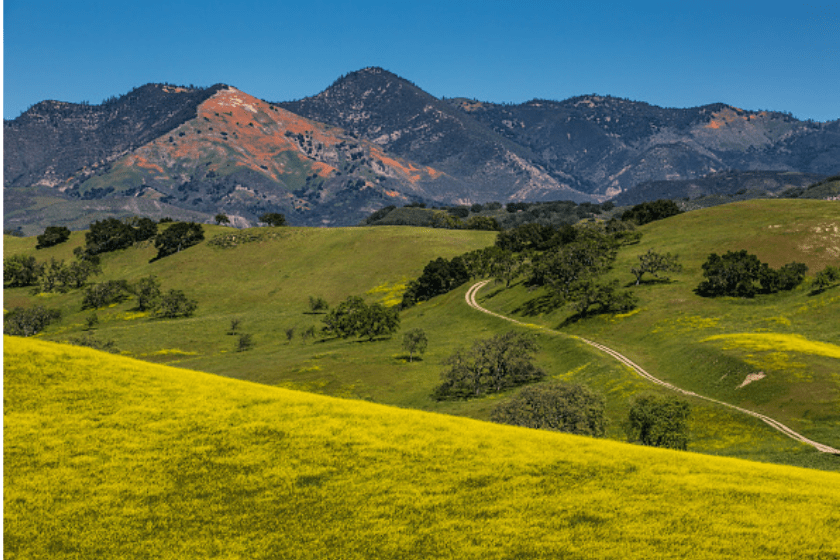
Getty Images
Located in the hills of the Santa Ynez Valley, just outside of Los Olivos, Grass Mountain is worth the steep climb to see the lupine- and poppy-covered hills. The over-4-mile trail covers a 2,000-foot elevation gain and takes about four hours to complete, especially when you stop for pictures of the spectacular views (or to catch your breath). The climb is a difficult one and can be slippery. Starting early and bringing poles is recommended. It also goes over multiple water crossings.
But, the mountainside is home to a breathtaking display of flowers that will only be viewable for another couple of weeks. Then, as temperatures warm up, the blooms will die off. The trail requires visitors to pick up a self-issued permit before parking and heading up the marked Midland School Trails.
Carrizo Plain National Monument
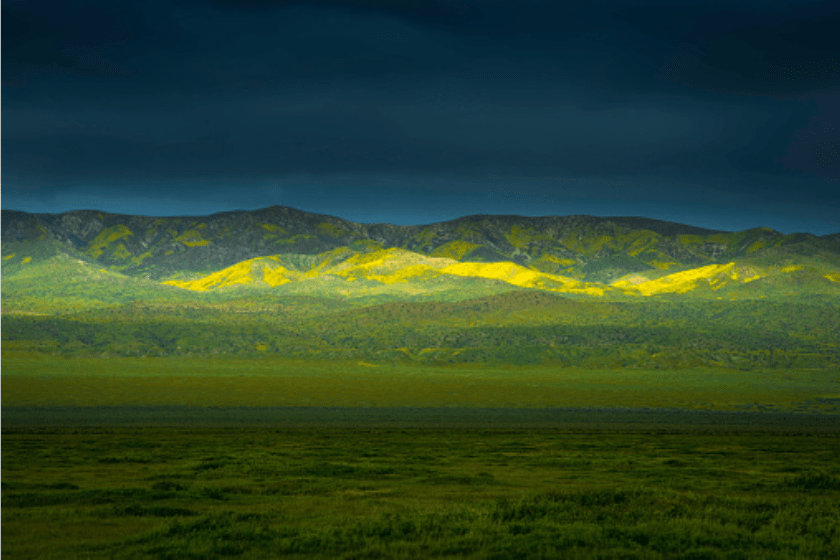
Getty Images
Run by the Bureau of Land Management, the Carrizo Plain National Monument offers visitors a peaceful spot to commune with nature. It's home to a wide variety of wildlife and plant life. The plains are also an important cultural location for Native Americans. The stunning super bloom covers the valley with wildflowers. Visitors can also see Soda Lake's white alkali flats, Painted Rock, the mountain-lined plains, and miles of grassland.
Eastern Kern County Onyx Ranch
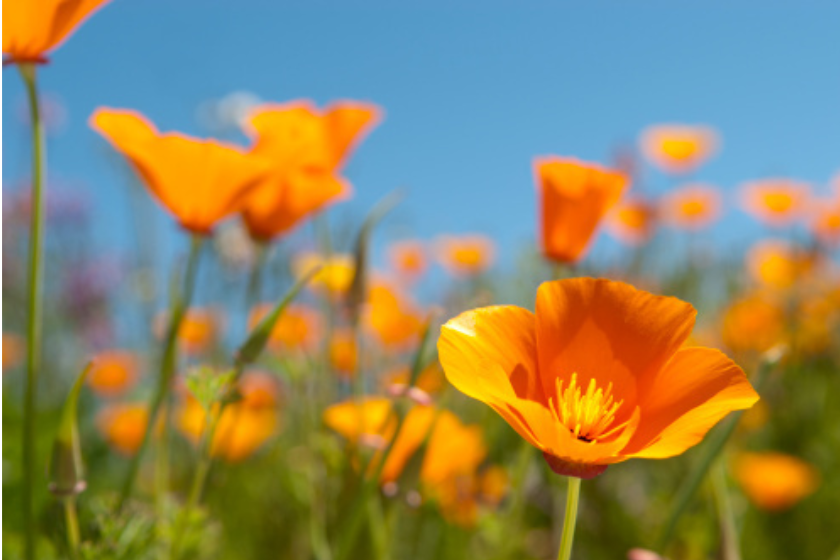
Getty Images
Located on the western edge of the Mojave Desert in Kern County is the Onyx Ranch SVRA. The 26,000-acre recreation area is open to various vehicles and recreation types, ranging from 2,200 to 6,400 feet. The park is open 24/7 from Oct. 1 through April 30. Wildflowers can be seen throughout the area. The area is the newest addition to the SVRA family, and currently there are no entrance fees.
Northern California
After being pelted by storm after storm with rain and snow, the north part of the state is lagging a little bit behind its southern neighbors. But that doesn't mean the super bloom won't happen. Like spring, it's going to take its sweet time to arrive. Lower areas that aren't submerged under feet of snow are seeing super blooms erupting with their vibrant colors, while parks bordering the California-Oregon are seeing hints of color to come. Want to see the super bloom now? The Bay Area is prime for super bloom admirers. Flowers farther north will debut in the next few weeks for those who are a little more patient.
Sugarloaf Ridge State Park
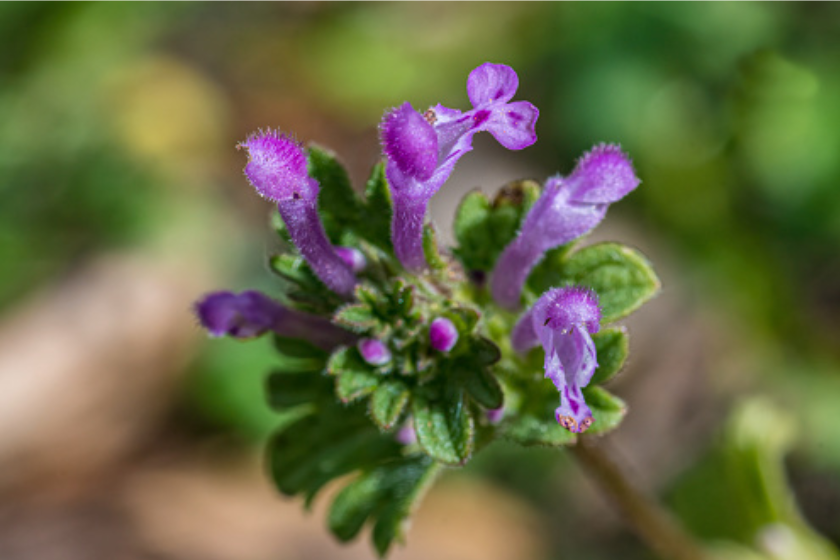
Getty Images
Not that we need another reason to love Sonoma, but the wildflowers in Sugarloaf Ridge State Park are a sight to behold. The park has over 25 miles of hiking and horseback riding trails nestled deep within oak trees, chaparral, and redwoods. Thanks to the heavy rains, the 25-foot waterfall from Sonoma Creek should be flowing for visitors to see. The water flows between the canyon and gorge, and beneath the rock outcroppings. The park also offers views of the Sierra Nevada, Bald Mountain and, on a good day, the Golden Gate Bridge.
The park is available for day use from 6 a.m. to 10 p.m. and for camping. The park expects a magnificent super bloom by May, but wildflower enthusiasts should check the park's social media feeds for updated information.
Buttermilk Bend Trail

Getty Images
Buttermilk Bend Trail is in Nevada County along the South Yuba River. The trail is known for meandering through wildflowers while the river flows below it. It's home to golden poppies, lupine, white daisy, larkspur, shooting stars, and western buttercups. The short trail is a little over a mile long and follows an old water ditch route. Along with river and wildflower views, hikers can see the oldest covered bridge, Bridgeport Covered Bridge, on the opposite side of the roadway. The river is open to kayaking and swimming, and is a popular summer location.
North Table Mountain Ecological Reserve
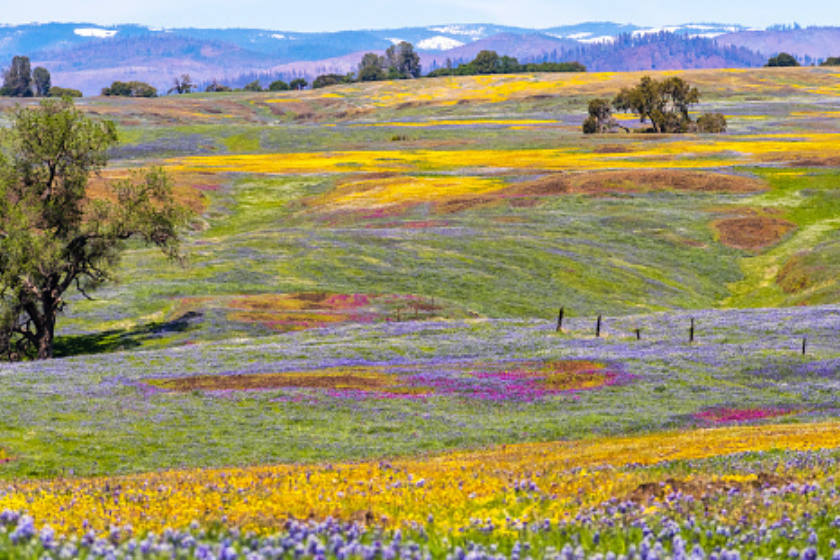
Getty Images
Butte County's North Table Mountain Ecological Reserve is quiet, but the super bloom has attracted many visitors. Visitors can also see Phantom Falls and the local cows as they graze along the reserve. To enter, visitors must pick up a lands permit either on the CDFW website or by scanning a QR code at the entrance and paying $5.40. All proceeds from the permit go back to the reserve. Dogs can also come to admire the flowers but must be kept on a leash. In addition, a permit is needed for drones.
Lassen Park Summit
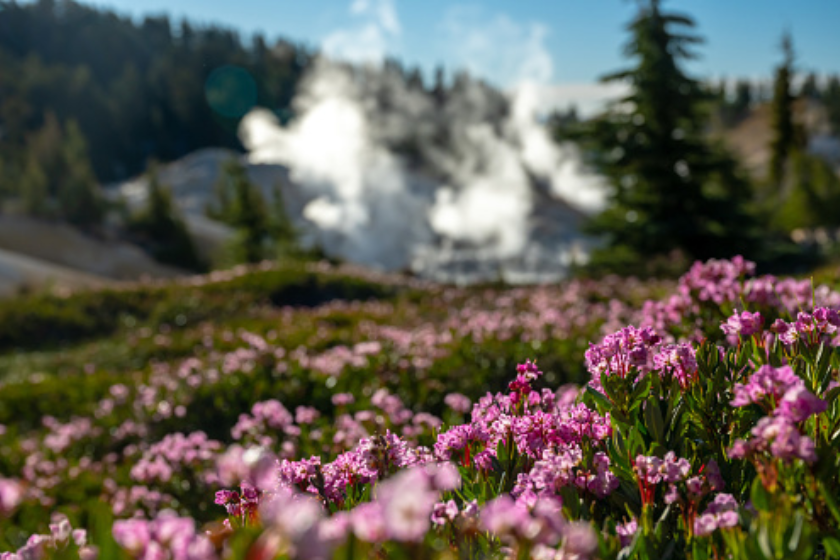
Getty Images
Lassen Volcanic Park has a multitude of magnificent sights. Come to see the wildflower-filled meadows and stay for the crystal-clear lakes, volcanoes, fumaroles, and massive peaks. Lassen is open to visitors 24 hours a day, seven days a week. However, access may be limited when there is snow, which can happen from November to May.
Due to the snowy weather, the super bloom happens much later in the season. Visitors can expect to see flowers toward the end of May through August. Lassen Peak is expected to bloom from late July through September. Of course, those are just rough estimates. Check the park's social media for updates before heading out.
Individual passes are $15 and are valid at the park for seven days. Cell service is limited within the park, so download park and trail directions for offline mode use ahead of time or while at the Kohm Yah-mah-nee Visitor Center, which has free Wi-Fi.
Where You Can't See Flowers This Year...
@getawaybunnies Those planning to visit the wild poppies of Walker Canyon this year are in for bad news ? the area is now off-limits and visitors could be cited. #superbloom #wildflowers #californiawildflowers #wildpoppies #californiapopies #walkercanyonpoppies #walkercanyon #whywecanthavenicethings #litterbugssuck #explorelosangeles #socallife
One location floral enthusiasts won't be able to see flora and fauna this year will be in Lake Elsinore. City officials have closed the location to visitors this year due to the trampling of flowers during the last super bloom. The city will ticket anyone who attempts to walk out onto the trails, and there is a chance trespassers will be arrested. Drivers on the 1-5 can view the flowers as they drive by, but that's as close as anyone will get to this small town. Thankfully, there are plenty of other locations to enjoy the flowers.
Remember, when enjoying the super bloom, stay on the trail, don't pick the flowers (plucking a poppy comes with a hefty fine), and don't leave anything behind. If the flowers get trampled, we run the risk of never being able to see the bloom the next time Mother Nature hits just right.
